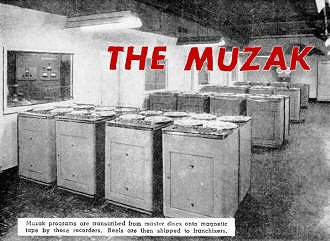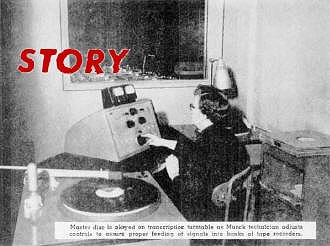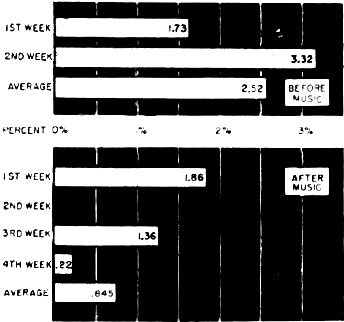The Muzak Story
|
|
Most people probably associate "elevator music" with the Muzak format. It became a registered trademark in 1954, although Muzak broadcasting was around a couple decades before that. Muzak music has also played in doctors' offices, restaurants, government public service facilities, buses, retail stores, and even workplaces (to provide calm and cadence for workers). According to the Wikipedia entry, the term "Muzak " was coined by its inventor, George Owen Squier (Major General, ret.) as a play on the made-up term "Kodak;" i.e., "Muz" (music) + "ak." Over the years, a lot of scientific research went into Muzak's format including genre of music, tempo, silence ("dead") time, volume, etc. Muzak has changed hands many times, including to Westinghouse, until it finally declared bankruptcy in 2010. If you type "muzak.com" into your browser now, you get redirected to moodmedia.com. Rumors have it that rocker Ted Nugent tried to buy Muzak in 1986 just to shut it down because it represented "all that is uncool about music." The Muzak Story Muzak programs are transcribed from master discs onto magnetic tape by these recorders. Reels are then shipped to franchisers. Improved service, greater range of selections, wider audiences, higher fidelity, and smoother operation are anticipated from recent changes behind the scenes at Muzak's New York headquarters. A remarkable new tape playback unit is the electronic cornerstone of this expansion move by the organization which has been furnishing background music in restaurants and other public places for twenty years. Designed by Muzak engineers, the tape unit is started and stopped automatically by subsonic signals on the tapes containing the musical programs. Desired music for special occasions, such as Christmas carols, may be preselected. In addition, the unit reverses the tape at the end of the 4800-foot reel, changes tracks, automatically rewinds, and shuts itself off and cuts in a companion tape mechanism. Since two of these playback units operating in tandem can play programmed music on tape indefinitely and automatically, Muzak maintains that the new system has not only eliminated human error from the operation, but has reduced operating procedures to one visit a day to change the reels in the studio. The tapes themselves, upon which Muzak records its own programs, are mounted on reels that can run a full eight hours, 4 hours in one direction on one track, and then 4 more hours on the other track in the opposite direction. Master disc is played on transcription turntable as Muzak technician adjusts controls to assure proper feeding of signals into banks of tape recorders. Tapes and playback units are shipped from Muzak's headquarters to its nearly 100 franchised operators. More than 400 communities are now serviced in this manner throughout the United States as well as in Lima, Peru; Vancouver, Toronto, and Montreal in Canada; Mexico City; San Juan, Puerto Rico; and Honolulu. It is estimated that 50 million people hear some portion of a Muzak program each day. Three Types of Programs Locations serviced by Muzak include restaurants, supermarkets, banks, department stores, business offices, and industrial plants. Three different kinds of programs have been developed to meet the calculated needs of these diverse situations. First, there is the "basic" program, consisting of a wide variety of classical and semi-classical music, show tunes, and popular songs (without vocals). Aimed at public places such as banks, restaurants and stores, this program is divided into 15 minute segments, with 12 1/2 minutes of music and 2 1/2 of silence. The silent period is calculated to prevent the unwelcomed effects of too constant background music. The second type of program, intended for offices, features a narrower variety of selections which omits classical music. This program is on for 15 minutes and off for 15 minutes, starting on the quarter-hour. The third, and most recent type, is the industrial program. Planned for factories and plants, this program comprises popular and show tunes exclusively and includes vocal selections. This program is scheduled like the office program - 15 minutes on and 15 off - but starts on the hour. Thus the factory schedule dovetails the office schedule, permitting an entire plant to be serviced simultaneously from one tape source. Music Played by " Name Bands" The musical selections themselves are obtained through a unique process. A composition is chosen. A special arrangement is made by staff musicians. The piece is then played for a recording session by one of the many "big-name" bands in the country, although the listener would never recognize the band since its playing is strictly in line with Muzak's arrangement and rules regarding tempo, volume, and orchestral effects. The master disc thus recorded is then used to make tape transcriptions. Tapes are recorded on 16-inch reels running at 3-3/4 i.p.s. using dual tracks. Subsonic signals, to be used later for switching on and off the playback units, are also recorded onto the tape. At one of Muzak's franchises, the tape is played back. Signals are fed to local amplifiers and thence, via lines, to the nearest telephone office. From here the signal is fed into lines that carry the music to the individual Muzak subscribers in that area. At the subscriber's installation, the signal is fed into a booster amplifier and finally to the loudspeaker. All the electronic equipment, including amplifiers and speakers, are Muzak products. Like the music itself, they are designed and built to Muzak specifications.
This chart, furnished by Muzak, shows the success of planned music in reducing lost time in one plant. Early departures dropped from 2.52% of man-hours during the two weeks before music was used to only 0.845% during the four weeks after Muzak was installed, representing a decrease of 66%. These measurements were made by the Stevens Institute of Technology. Muzak's conclusions: a cheerful worker is a better worker; the right kind of music helps make, and keep, men happy. Muzak's 7000 different musical selections make it possible never to program the same number more than once a day; usually it is not necessary to repeat it for an entire week. The unique tonal qualities of this music have occasioned comment by many listeners. Muzak's programs are noted for their subdued overtones, lack of stridency, and over-all "mellowness ". This quality is not an indication of musical ignorance on the part of the organization, but a deliberate attempt to provide the kind of music that makes good background for various activities. According to Muzak, this music actually helps people work, shop, or dine, and is non-distracting. The philosophy behind Muzak is that such music cheers people, boosts morale, increases the positive psychological factors in human behavior, helps increase work output, minimizes fatigue, and makes public places more pleasant so that large numbers of people can function smoothly without running each other down. In line with these points, the programming and timing of the music are based on the "Standard Fatigue Curve" developed by psychologists. Because the music is designed primarily as background and to blend into the surrounding atmosphere, the over-all response of the system is controlled to permit the transmission of "tones that just penetrate the noise barrier" created by any given set of activities and people. Described by Muzak as a "controlled high fidelity that preserves the quality of the original performance, but eliminates all irritating highs," this music is played and reproduced in such a way as not to call attention to itself. It simply serves as a psychological aid to whatever else is going on. Experience, tests, and increasing franchises all seem to indicate that for fulfilling its avowed aims, "music by Muzak" is here to stay!
Posted September 26, 2023 |
|



